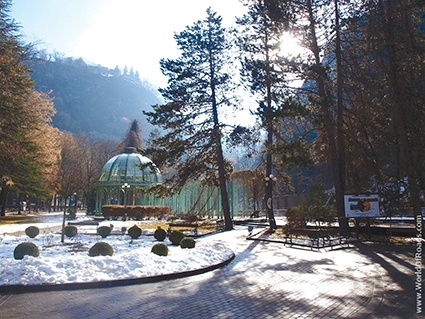Borjomi's Return to Status of Leading Tourist Destination
It was the fresh air together with the smell of pine trees which grabbed me. In the forest up on the hill above Borjomi, lumbermen had been cutting trees and now I was surrounded by the strong smell of wood. The weather was mild with the occasional ray of sunshine peeking through the clouds on the late autumn day. The cable car up to the hill was still working, and two young Russian tourists eagerly took a ride. But it was obvious that the season was drawing to a close. The ferris wheel had stopped turning, the restaurant was locked.
“High season in Borjomi is during the summer. In July and August it can be hard to find a room,” says Keti Berozashvili, Head of Tourism at the Municipality of Borjomi. “A lot of families come for the air in the summer and stay in the town proper or in the surrounding villages for one or two weeks- it’s still reviving since tourism stopped in the 1990s.”
Borjomi also usually experiences some tourist flow after the first snowfall- with visitors coming to take the ice-cold forest air and a cup or two of mineral water on their way to or from the nearby Bakuriani ski resort.
The town has been famous for its mineral spring since the 19th century. And even today Borjomi is a well-known brand still sold in many former Soviet countries. This is probably the reason Borjomi attracts a lot of tourists from Ukraine, Azerbaijan, Kazakhstan and, despite political tensions, also from Russia. Such guests tend to go for the classic spa hotels or sanatoriums, with baths, massage, and mineral water treatments – just like they did in Soviet times.
Walking through the main street of Borjomi, you can still catch a hint of those Soviet times: Socialist architecture, run-down houses and former hotels, sometimes unused- it certainly doesn't have the splendor of some European mountain resorts. Nonetheless, you can feel the effort Borjomi is putting in to become a leading tourist destination in the region again – and to attract western tourists.
To this aim, Borjomi is focusing on ecotourism and agrotourism. Berozashvili sees huge potential in this field, especially regarding European tourists. “Already the region is offering activities like hiking, biking and horse riding in cooperation with the local people in the villages. And the Municipality wants to expand this sector,” she says. “The problem is it's not always easy to convince the local population of the value of ecotourism.”
Borjomi has a big advantage over other tourist destinations: it is located next to the National Borjomi-Kharagauli Park, the largest National Park in Georgia. The Park Administration started in 2003 to create the first hiking trail. “Now there are different trails of up to four days long and shelters for overnight stays (tourists can rent sleeping bags and tents). And recently the Park Administration invested in better marking for the trails following visitor feedback,” says Park director, Levan Tabunidze.
And it seems the tourists do appreciate this effort. The number of visitors is increasing rapidly, in the current year by 15 percent so far. And for those tourists looking for pure nature, it's probably a plus that Borjomi doesn't have the splendor of Western mountain resorts just yet.
Lukas Mäder












